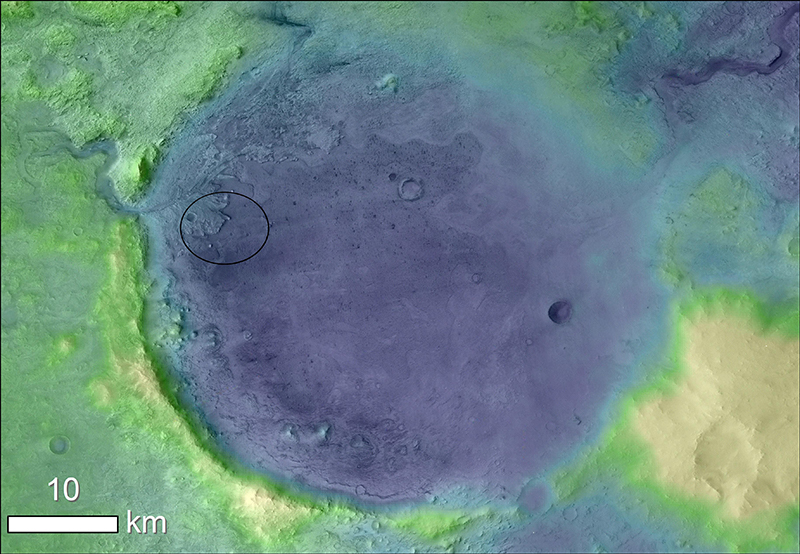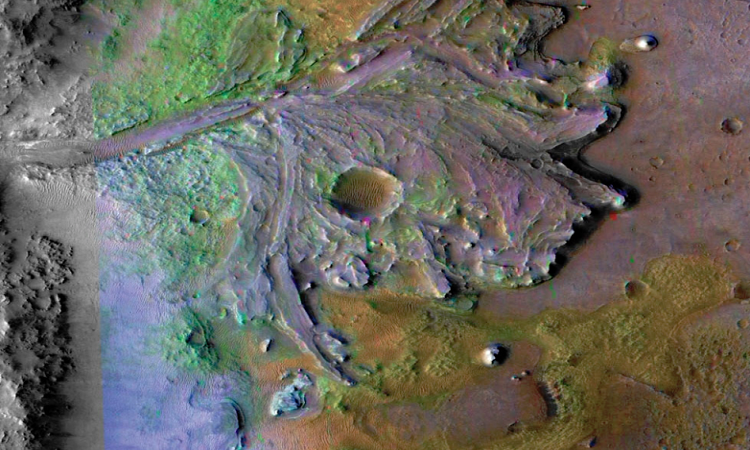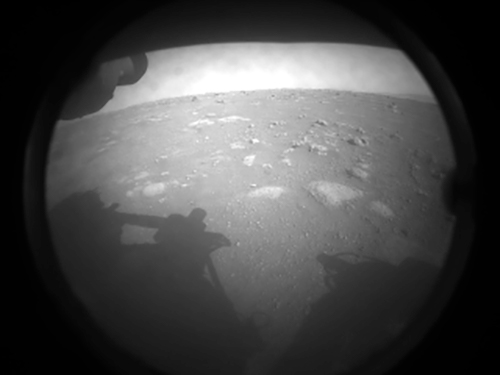The Perseverance rover will look for signs of ancient life in Jezero crater, a spot Brown researchers have studied for years and championed during the site-selection process.
PROVIDENCE, R.I. [Brown University] - After a journey of seven months and more than 300 million miles, NASA's Perseverance rover landed successfully on the surface of Mars on Thursday, Feb. 18. It now begins its search for signs of ancient life in Jezero crater, which was home a few billion years ago to a body of water about the size of Lake Tahoe.
It was planetary scientists at Brown who first put Jezero on the radar as a potential exploration site, and they're excited to finally get a rover's-eye view this ancient Martian lake.
"Brown has been really instrumental in both locating this lake and documenting [its mineralogy and hydrology]," said Jim Head, a research professor of planetary sciences at Brown. "All the papers we've written and discussions and talks we've given really caught people's attention and resulted in the ultimate selection of this for the... landing site."
The story of Jerezo's discovery, investigation and ultimate selection as a rover destination is one of long-term collaboration by faculty and student researchers in Brown's Department of Earth, Environmental and Planetary Sciences.
It all started in 2004 when Caleb Fassett, a Brown graduate student at the time, was looking through images of the Martian surface searching for signs of open-basin lakes - systems in which water flows into one side of a basin, overtops the rim and flows out. These lakes are of interest because they require lots of water that potentially stays on the surface for an extended period - the makings of a habitable environment.
During his prospecting, Fassett found a then-unnamed crater (it was named Jezero, a Slavic word for "lake," in 2007) with inlet and outlet channels that are the tell-tale signs of an open-basin lake. But there was something else that made the crater stand out: It had an exquisitely preserved river delta.
"Suddenly we see this delta pop out and we're like, 'my goodness, look at this!'" Head said.
On Earth, river deltas are particularly good at preserving fossils and other types of biosignatures. So a delta on Mars was of immediate interest, and that interest only deepened as more Brown scholars looked at the site.
In 2008, research led by Bethany Ehlmann, a graduate student at the time and now a professor at Caltech, showed that Jezero's crater and its delta were rife with clay and carbonate minerals - key indicators of a habitable environment. The work "elevated the science priority of the region immediately," said Jack Mustard, a Brown professor, Ehlmann's advisor and a coauthor on the paper. "It showed that this site has real astrobiological implications."
From there, another student working with Head and Mustard took up the Jezero mantle. Tim Goudge, now an assistant professor at the University of Texas at Austin, led a 2015 study that detailed the ancient hydrology of the Jezero lake systems, showing that Jezero actually recorded the history of two separate water events on Mars - one event that created the rich mineralogy seen in the delta deposits, and another flooding event that washed those minerals into the crater.
"At Jezero, you're gathering all this material from this huge watershed and dumping into one place," Goudge said at the time the research was published. "So if there perhaps was any biologic or organic material in the watershed, you might have transported some of that to the basin."
It was Goudge who led the charge for Jezero during a series of landing site selection workshops held by NASA starting in 2014. The site quickly climbed to the top of more than 50 sites submitted for consideration, and was ultimately the one chosen by NASA. Goudge's presentations drew on work by Head, Mustard, Fassett and Ehlmann, a host of other former graduate students, and current Brown student Chris Kremer.
With Perseverance safely on the ground, Goudge says he's excited to get a close-up view of terrain that's only been seen from orbit. He says the eroded face of the delta should have "gorgeous sedimentary structures exposed - think the beautiful rock formations of the desert Southwest in the U.S."
Deposits atop the delta, which capture the meanderings of the river that flowed into the crater, promise to be equally striking.
"These exposures are, from orbit, some of the most striking sedimentary structures we see on Mars, so up-close, they'll certainly have an even more remarkable level of complexity," he said. "Pretty much everywhere the rover will go, though, is somewhere I'm keen to see from the ground."
Mustard served as chair of the mission's Science Definition Team, which was tasked with outlining the mission's scientific objectives. He says the rover has an exquisite set of tools for interrogating the rocks in Jezero's delta, the crater floor and even outside during the Perseverance's extended mission.
"The carbon detection instruments are super exciting for being able to find carbon-rich zones in the rocks," Mustard said. "It has a radar for imaging the subsurface. And the remote sensing instruments, coupled with super high-resolution instruments on the rover's huge arm, permit this really neat nesting of observations, beginning with a wide field of view and drilling down to the millimeter scale. It will be amazing!"
Head says he's interested to learn more about the hydrological history of the lake, and what that may say about the past climate of Mars.
"One of the things we want to know is whether this lake formed over the course of a few thousand years, or was it around for tens-of-millions of years," he said. "We really don't know that, and believe it or not, either one is plausible. The layers in the Delta will tell us what's going on."
Perseverance will also create a cache of particularly interesting rock samples, which will stay on the surface to be retrieved by a future mission and brought back to Earth. Lab studies of those rocks would be definitive in assessing whether they hold signatures of ancient life.
Head says this new mission continues a long legacy of Mars research at Brown. The late Brown professor Tim Mutch led the team that developed the imaging system for the Viking 1 lander, which reached the Red Planet in 1976 and returned the very first pictures taken from the Martian surface. Brown scientists have been active in Mars research ever since.
"This is another step in the exploration of one of the most Earth-like planets in our solar system, and the quest to understand the origin and evolution of life," Head said. "That is, I think, one of the most fundamental unanswered questions that we have."






